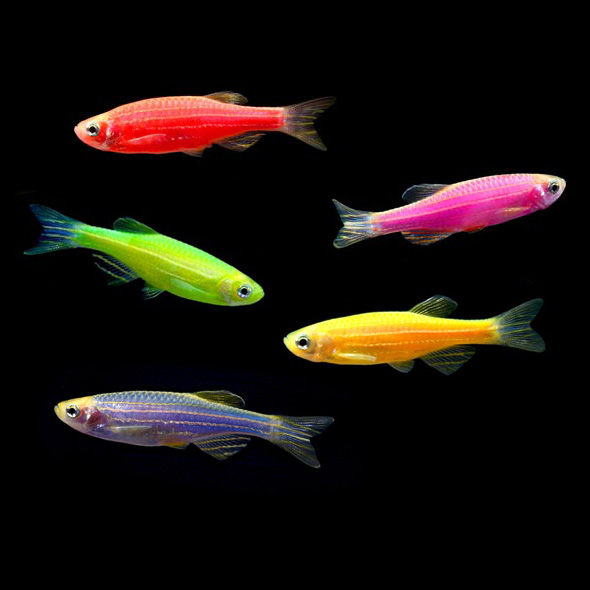
Frankenstein's Cat: Cuddling up to Biotech's Brave New Beasts by Emily Anthes explores how biotechnology and genetic engineering are changing the animals around us. The book delves into the science behind these new creatures as well as the ethical issues and public perceptions. The result is an easy and interesting read that makes you imagine the genetically engineered animals that could be on the horizon.
 GloFish were the first commercially available pets created using biotechnology. By inserting the gene that makes jellyfish glow (green fluorescent protein, or GFP) into a common pet store find (zebrafish), the inventor was able to create a fish that glowed green in certain lights. Despite seeming relatively benign, the company was required to perform extensive research on the possible environmental impacts in case of escape before GloFish were approved for sale in 2003. Interestingly, consumers had few concerns about these new creatures and were willing to pay almost 20 dollars for each fish. The company now has a variety of other colors and species available and sells special tanks to help you enjoy their fluorescent fish.
GloFish were the first commercially available pets created using biotechnology. By inserting the gene that makes jellyfish glow (green fluorescent protein, or GFP) into a common pet store find (zebrafish), the inventor was able to create a fish that glowed green in certain lights. Despite seeming relatively benign, the company was required to perform extensive research on the possible environmental impacts in case of escape before GloFish were approved for sale in 2003. Interestingly, consumers had few concerns about these new creatures and were willing to pay almost 20 dollars for each fish. The company now has a variety of other colors and species available and sells special tanks to help you enjoy their fluorescent fish. The chapter on animal cloning starts with Dolly the sheep (the first cloned animal) and makes some interesting stops along the way. The story of Carbon Copy (CC), the first cloned cat (sometimes called Copy Cat), is scientifically notable because CC doesn't look much like her calico mother Rainbow. This is due to a process called X chromosome inactivation (you can learn more about this process in my recent post on Junk DNA). The gene for orange fur is on the X chromosome. CC's genome has an inactive copy of the X chromosome from her clone mother. Thus, while CC is genetically identical, she is phenotypically different. This result was interesting to scientists, but it likely gave future customers of cat cloning some pause–what's the point of paying to have your favorite cat cloned if you can't be sure you will get a cat that looks the same?
The chapter on animal cloning starts with Dolly the sheep (the first cloned animal) and makes some interesting stops along the way. The story of Carbon Copy (CC), the first cloned cat (sometimes called Copy Cat), is scientifically notable because CC doesn't look much like her calico mother Rainbow. This is due to a process called X chromosome inactivation (you can learn more about this process in my recent post on Junk DNA). The gene for orange fur is on the X chromosome. CC's genome has an inactive copy of the X chromosome from her clone mother. Thus, while CC is genetically identical, she is phenotypically different. This result was interesting to scientists, but it likely gave future customers of cat cloning some pause–what's the point of paying to have your favorite cat cloned if you can't be sure you will get a cat that looks the same?Anthes tours a wildlife preserve and research center in Louisiana where researchers aim to develop and perfect methods for cloning animals with the long-term goal of preservation of endangered species. This is certainly worthwhile goal, but the barriers, both technical and ecological, are numerous. To me, the biggest problem with saving a species through cloning is the lack of genetic diversity. Until these problems are solved, many are banking on frozen zoos, large stocks of samples from a variety of animals that are endanger of extinction. The hope is that once cloning technology improves, it may become viable to add to the existing populations.
 |
| Roboroach from Backyard Brains |
The book concludes with predictions of what may be possible in the future, like creating farm animals that are resistant to disease to decrease the use of antibiotics. Frankenstein's Cat was published in 2013 and the field has made amazing progress since that time. With the advent of the new genome editing technique CRISPR, the possibilities are truly endless, which has led to concerns about the ethical and safety considerations of this technology. Earlier this week a Chinese Institute caused a stir with its announcement of the commercial availability of gene-edited micro-pigs as pets. It will be interesting to see where we draw the line on genetically modified animals.